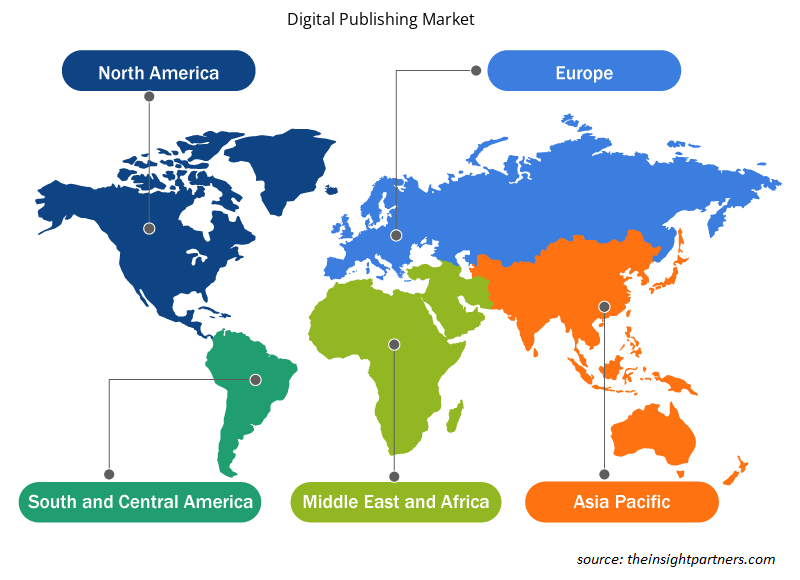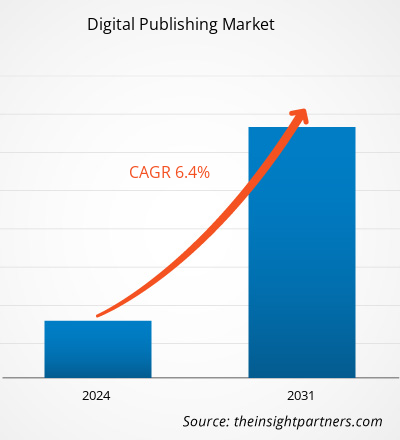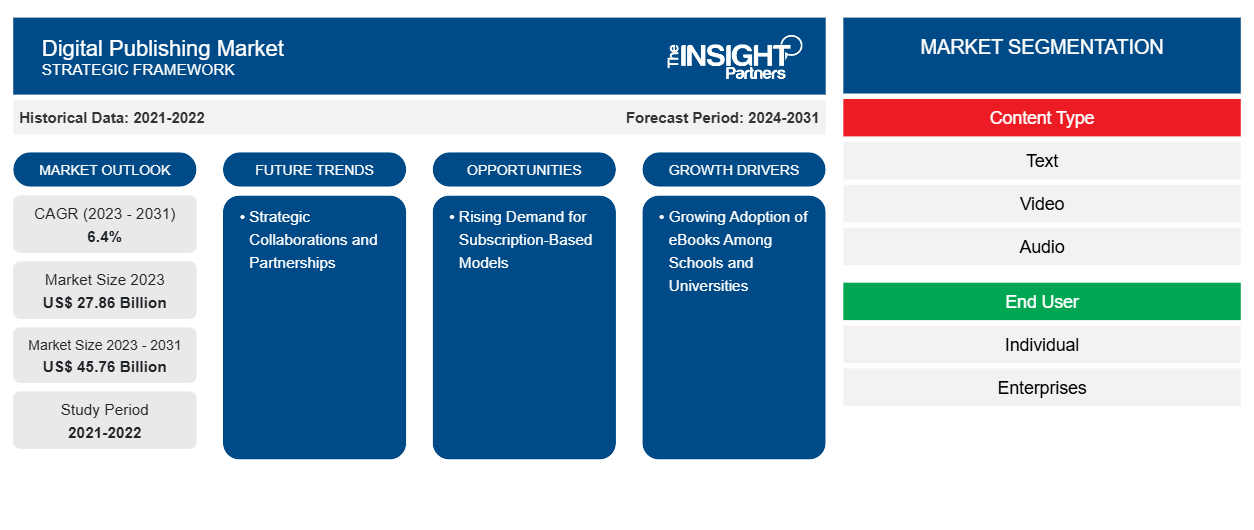디지털 출판 시장 규모는 2023년 278억 6천만 달러에서 2031년 457억 6천만 달러로 성장할 것으로 예상됩니다. 이 시장은 2023~2031년 동안 6.4%의 CAGR을 기록할 것으로 예상됩니다 . 전략적 협업과 파트너십은 시장에서 핵심 트렌드로 남을 가능성이 높습니다.
디지털 출판 시장 분석
디지털 출판은 전통적인 인쇄 출판 방식을 빠르게 대체하고 있습니다. 게다가 COVID-19 팬데믹은 디지털 출판의 성장을 촉진하는 다른 요인들과 함께 디지털 미디어의 증가를 촉진했습니다. 출판사들은 디지털 출판을 선택함으로써 유통을 빠르게 늘리고 현재 수익원을 확대하고 있습니다. 위의 요인들 외에도, 향후 6~7년 동안 디지털 출판의 성장에 영향을 미칠 것으로 예상되는 몇 가지 새로운 디지털 출판 기능이 있습니다. 예를 들어, 제품을 구현하는 데 있어 문서화와 단순성, 그리고 빠르고 간편하게 액세스할 수 있는 성능과 사용자 경험은 사용자 유지, 콘텐츠 수익화, 전자 상거래 통합을 위해 오리지널 콘텐츠나 사용자가 생성한 콘텐츠에 대한 필요성을 촉진합니다.
디지털 출판 시장 개요
전자 또는 온라인 출판이라고도 하는 디지털 출판은 저널, 잡지, 신문, 전자책과 같은 다양한 온라인 콘텐츠를 배포하는 것을 포함합니다 . 이 과정을 거치면 모든 사업체 또는 출판 기관은 종이 문서와 데이터를 디지털 형식으로 변환할 수 있으며, 이는 온라인에서 액세스하고, 다운로드하고, 편집하고, 사용자의 재량에 따라 인쇄하거나 공유할 수 있습니다.
귀하의 요구 사항에 맞게 이 보고서를 사용자 정의하세요
이 보고서의 일부 또는 국가 수준 분석, Excel 데이터 팩을 포함하여 모든 보고서에 대한 사용자 정의를 무료로 받을 수 있으며 신생 기업 및 대학을 위한 훌륭한 혜택과 할인 혜택을 이용할 수 있습니다.
-
이 보고서의 주요 시장 동향을 알아보세요.이 무료 샘플에는 시장 동향부터 추정 및 예측까지 다양한 데이터 분석이 포함됩니다.
디지털 출판 시장의 동인과 기회
학교와 대학에서 전자책 채택이 늘어나 시장 선호
전자책은 교육 기관이 세 가지 주요 전략적 목표를 달성하도록 지원합니다. 즉, 경쟁이 치열한 환경에서 학생 경험과 학업 성취도를 높이고, 교육, 학습 및 연구의 혁신을 촉진하며, 공간과 인력 자원을 최적으로 활용하는 데 도움이 됩니다. 대학과 도서관의 경우, 중요한 도서의 적시 가용성을 보장하는 것이 오랜 문제였으며, 학생 설문 조사에서 가장 큰 불만은 사본 수가 부족하다는 것이었습니다. 학생들은 언제 어디서나 전자책에 쉽게 액세스할 수 있으므로, 보다 효율적인 방식으로 기대에 부합하는 편리한 옵션입니다.
또한 교육, 훈련 및 탐험 의 발전이 디지털 출판의 글로벌 수용에 영향을 미치고 있습니다. 예를 들어, 레스터 대학교는 온라인 학습을 통해 보안, 갈등 및 국제 개발 분야의 석사 학위를 제공합니다 . 범죄학과는 국제 개발 부문에 종사하거나 이 분야에 종사하고자 하는 개인을 위한 맞춤형 프로그램을 제공합니다. 이 프로그램의 학생들은 전형적인 교실 환경에서 벗어나 군사 시설, 외딴 지역 또는 평화 유지군으로 일할 수 있습니다. 각 학생은 수업 자료, 전자책 및 액세스를 위한 수업 앱이 포함된 iPad를 받습니다. 학생들은 직장에 안정적인 인터넷 연결이 없어도 이러한 전자책에 액세스하여 읽을 수 있으며, 이러한 인터넷 연결은 종종 사용할 수 없거나 신뢰할 수 없습니다. 교육 기관에서 전자책 사용이 증가함에 따라 전 세계 디지털 출판 산업이 확장되고 있습니다.
구독 기반 모델에 대한 수요 증가
변화하는 온라인 환경은 유연성을 요구하며, 퍼블리셔는 수입원을 다양화해야 합니다. 그들은 일반적인 광고 및 구독 모델을 넘어 재정적 안정성을 보장할 새로운 방법을 모색하고 있습니다. 이 새로운 전략은 다양한 방식으로 나타납니다. 브랜드가 관련 콘텐츠에서 함께 작업하는 스폰서 콘텐츠 파트너십이나 퍼블리셔가 제품이나 서비스를 마케팅하고 수수료를 벌어 수익을 올리는 제휴 마케팅을 통해 말입니다. 이벤트를 조직하거나 온라인 과정을 만드는 것은 독자와 직접 상호 작용할 수 있는 방법을 제공합니다. 이는 보다 깊은 유대감과 더 많은 수입 가능성을 만듭니다. 퍼블리셔는 개별 사용자의 요구를 맞춤화하고 충족하기 위해 현재의 방법을 재평가하고 있습니다. 점점 더 인기를 얻고 있는 소액 결제는 독자가 전체 구독 서비스에 가입하는 대신 개별 기사에 대해 소액의 수수료를 지불할 수 있게 하여 더 많은 유연성을 제공하고 다양한 소비 습관을 충족합니다.
디지털 출판 시장 보고서 세분화 분석
디지털 출판 시장 분석에서 중요한 요소는 콘텐츠 유형과 최종 사용자입니다.
- 콘텐츠 유형에 따라 시장은 텍스트, 비디오, 오디오로 세분화됩니다. 비디오 세그먼트는 2023년에 상당한 시장 점유율을 차지했습니다.
- 최종 사용자 측면에서 시장은 개인과 기업으로 나뉩니다. 개인 세그먼트는 2023년에 시장에서 상당한 점유율을 차지했습니다.
지역별 디지털 출판 시장 점유율 분석
디지털 출판 시장 보고서의 지리적 범위는 주로 북미, 아시아 태평양, 유럽, 중동 및 아프리카, 남미 및 중미의 5개 지역으로 나뉩니다.
북미는 2023년에 상당한 디지털 출판 시장 점유율을 차지할 것으로 예상됩니다. 이 지역의 디지털 출판 시장 수요 증가는 개선된 디지털 출판에 대한 필요성이 커짐에 따라 촉진되었습니다. Adobe Inc., Apple Inc., Amazon.com Inc., Alphabet Inc. 등과 같은 주요 시장 리더는 파트너십, 인수, 신제품 및 개선 사항 개발에 참여하고 있으며, 이는 이 지역의 시장 성장을 촉진하고 있습니다. Comcast Inc.가 2021년 3월에 TV를 위한 중앙 집중식 광고 캠페인 관리와 연결하기 위한 새로운 솔루션을 공개한 것이 그 예입니다.
디지털 출판 시장 지역 통찰력
Insight Partners의 분석가들은 예측 기간 동안 디지털 출판 시장에 영향을 미치는 지역적 추세와 요인을 철저히 설명했습니다. 이 섹션에서는 북미, 유럽, 아시아 태평양, 중동 및 아프리카, 남미 및 중미의 디지털 출판 시장 세그먼트와 지리적 분포도 논의합니다.

- 디지털 출판 시장을 위한 지역별 데이터 얻기
디지털 출판 시장 보고서 범위
| 보고서 속성 | 세부 |
|---|---|
| 2023년 시장 규모 | 278억 6천만 달러 |
| 2031년까지 시장 규모 | 457억 6천만 달러 |
| 글로벌 CAGR (2023-2031) | 6.4% |
| 역사적 데이터 | 2021-2022 |
| 예측 기간 | 2024-2031 |
| 다루는 세그먼트 |
콘텐츠 유형별
|
| 포함된 지역 및 국가 |
북아메리카
|
| 시장 선도 기업 및 주요 회사 프로필 |
|
디지털 출판 시장 참여자 밀도: 비즈니스 역학에 미치는 영향 이해
디지털 출판 시장 시장은 소비자 선호도의 변화, 기술 발전, 제품의 이점에 대한 인식 증가와 같은 요인으로 인해 최종 사용자 수요가 증가함에 따라 빠르게 성장하고 있습니다. 수요가 증가함에 따라 기업은 제품을 확장하고, 소비자의 요구를 충족하기 위해 혁신하고, 새로운 트렌드를 활용하여 시장 성장을 더욱 촉진하고 있습니다.
시장 참여자 밀도는 특정 시장이나 산업 내에서 운영되는 회사나 기업의 분포를 말합니다. 주어진 시장 공간에 얼마나 많은 경쟁자(시장 참여자)가 존재하는지 그 규모나 전체 시장 가치에 비해 나타냅니다.
디지털 출판 시장에서 운영되는 주요 회사는 다음과 같습니다.
- 휴릭스디지털
- 비주아
- VitalSource 기술
- 엑셀소프트 테크놀로지스
- 임펠시스 주식회사
- 이수우
면책 조항 : 위에 나열된 회사는 어떤 특별한 순서에 따라 순위가 매겨지지 않았습니다.

- 디지털 출판 시장의 주요 기업 개요를 알아보세요
디지털 출판 시장 뉴스 및 최근 개발
디지털 출판 시장은 1차 및 2차 연구 이후의 질적, 양적 데이터를 수집하여 평가합니다. 여기에는 중요한 기업 출판물, 협회 데이터, 데이터베이스가 포함됩니다. 디지털 출판 시장의 몇 가지 개발 사항은 다음과 같습니다.
- FlipHTML5는 혁신적인 AI 전자책 제작기를 선보이며 디지털 출판 산업에 혁명을 일으키고 있습니다. 이 고급 도구는 전자책 제작을 간소화하여 사용자가 전문적이고 대화형 전자책을 원활하게 제작할 수 있도록 합니다.
(출처: PR UNDERGROUND, 보도자료, 2024년 6월)
- 디지털 퍼블리셔와 크리에이터에게 더욱 강력한 힘을 실어주기 위한 대담한 움직임으로, Ezoic은 기대를 모았던 Enterprise 프로그램을 방금 출시했습니다. 엔터프라이즈 규모의 크리에이터를 위해 명확하게 설계된 이 포괄적인 서비스와 기능 모음은 Ezoic의 제공 범위를 상당히 확장하여 대규모 디지털 퍼블리셔와 비디오 크리에이터의 고유한 요구를 충족하는 맞춤형 솔루션을 제공합니다.
(출처: Ezoic, 회사 웹사이트, 2023년 3월)
디지털 출판 시장 보고서 범위 및 제공물
"디지털 출판 시장 규모 및 예측(2021-2031)" 보고서는 아래 영역을 포괄하는 시장에 대한 자세한 분석을 제공합니다.
- 범위에 포함된 모든 주요 시장 세그먼트에 대한 글로벌, 지역 및 국가 수준의 디지털 출판 시장 규모 및 예측
- 디지털 출판 시장 동향과 동인, 제약, 주요 기회와 같은 시장 역학
- 자세한 PEST/포터의 5가지 힘과 SWOT 분석
- 주요 시장 동향, 글로벌 및 지역 프레임워크, 주요 업체, 규정 및 최근 시장 개발 사항을 포괄하는 디지털 출판 시장 분석
- 시장 집중도, 히트맵 분석, 유명 업체 및 디지털 출판 시장의 최근 개발 사항을 포함하는 산업 환경 및 경쟁 분석
- 자세한 회사 프로필
- 과거 분석(2년), 기준 연도, CAGR을 포함한 예측(7년)
- PEST 및 SWOT 분석
- 시장 규모 가치/거래량 - 글로벌, 지역, 국가
- 산업 및 경쟁 환경
- Excel 데이터세트
최근 보고서
관련 보고서
사용 후기
구매 이유
- 정보에 기반한 의사 결정
- 시장 역학 이해
- 경쟁 분석
- 고객 인사이트
- 시장 예측
- 위험 완화
- 전략 기획
- 투자 타당성 분석
- 신흥 시장 파악
- 마케팅 전략 강화
- 운영 효율성 향상
- 규제 동향에 발맞춰 대응























 무료 샘플 받기 - 디지털 출판 시장
무료 샘플 받기 - 디지털 출판 시장